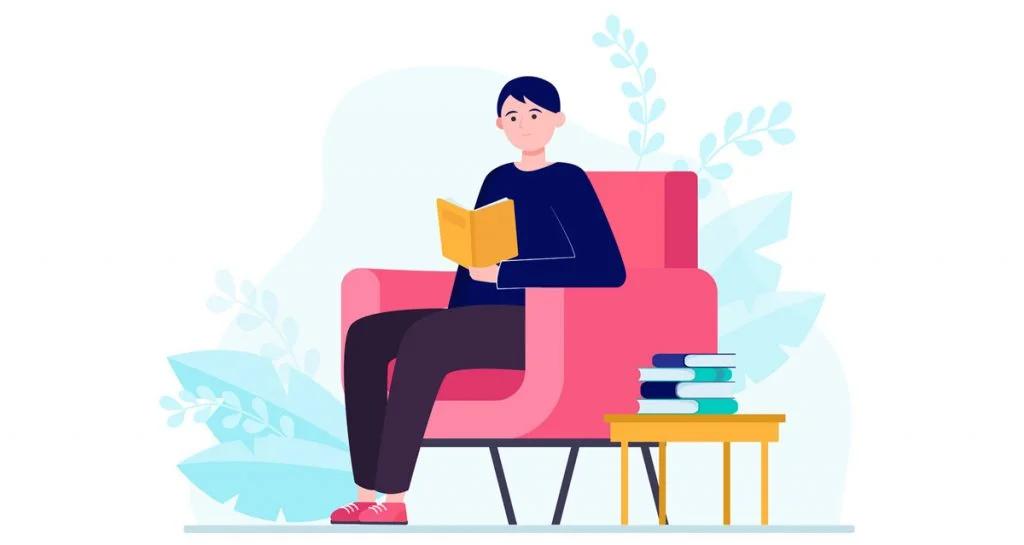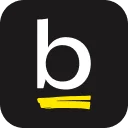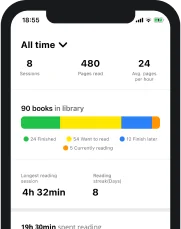While it might be easy for some readers to read and remember a good chunk of what they read – whether they enjoyed the book or not – it’s, however, super difficult for others to recall books, plots, or even characters in the story.
Does this mean that there’s something wrong with you if you can’t remember everything you’ve read? Absolutely not! The human brain is tricky like that and it’s part of its defense mechanism to let go of some information to make room for other data. Forgetting something you’ve read (even if you’ve done it fairly recently) is very common — especially among avid readers.
In this article, we will take a closer look at some handy tips and tricks on how to remember what you read including the lists of books that you have also read, which is also extremely important.
If you feel a bit down because of this issue, you’re not alone — not remembering what they’ve read is a real problem that’s costing most people a remarkable reading experience.
So, how can you – whether you are an avid reader or simply just starting out – ensure that you get the best out of your reading experience by remembering what you have read?
Let’s find out!
So, How to Remember What You Read?
There is no one-size-fits-all when it comes to remembering what you’ve read. Different people have different preferences. Try the ones below to find out which of them matches your style and your needs:
1. Take Notes as You Read
This is probably one of the most commonly used methods of internalizing what you’ve read. It’s a tactic that most readers have used mostly because it’s what we were taught in school. As old as the method is, it is quite effective nonetheless as most people will remember points they jotted down in a notebook without too much fuss.
However, jotting down points in a notebook can be somewhat exhausting for some. That’s why you should delegate such a task to a reading app like Basmo.
Thanks to technology, there’s a smarter way to take notes without actually taking notes. Plus, you can have them stored in a centralized location that you can easily access at any time instead of scattered across dozens of notebooks.
When you start a reading session on Basmo, you have the option to Write your thoughts. You can use it any time during your reading session to write down your favorite quotes or a few notes about the book.
- Click on the + sign to search for the book you’re currently reading. A list with possible book titles and authors will pop up.
- Once you’ve found the book, tap on it. To start your reading session, tap again on that book and on the Start Session button.
- Now that the timer’s started, you can close your phone and start reading your book.
- Anytime you want to take notes, just open back the app. You’ll find a special section dedicated to writing your thoughts.
- When you’re done, you can tap on the End Session section, you’ll set your bookmark page so you’ll know where you left off, and you’re done for the day!
With Basmo, you can take screenshots of your favorite paragraphs and read them again later – a nifty little feature that can transform your reading.
2. Visualize What You’ve Read
Most books, novels to be precise, do not have photos or images as part of the story. Reading hundreds of pages of text without some sort of visual aid can be challenging for most readers. To overcome this, you should try to visualize things you read about as much as possible.
This tactic helps you to create a mental picture of what you’ve just read, making it easier for you to remember parts of the story – at least the interesting ones or the ones that matter most.
3. Clarify the Things You’ve Read
If you want the book you’ve just finished reading to stick with you for longer, try to avoid glossing over the chapters so that you can finish the book and grab the next one. Not unless your main aim is to read as many books as possible within a given period of time.
“Remembering how I feel about certain things is enough. I don’t need to remember the things themselves, too.”
Friedrich Nietzsche
This quote fits memorizing what you’ve read as well. If you can remember how a certain book or a certain chapter made you feel, you will remember it better.
Use Basmo to write down your feelings. After every reading session in Basmo, you can reflect on your reading and assign an emotion to that session. Later on, when you see the emotion you’ve assigned to it, it will be easier to remember what you’ve read, too.
Retaining what you’ve read is all about understanding what you’ve read. If there’s a section or chapter that you haven’t quite understood, by all means, read it again to clarify what it’s all about. There’s absolutely no need to move on to the next chapter if the last few pages of the last one didn’t make any sense to you.
4. Make Connections with Real-Life Events
We all have a strong connection to the things we love. We also easily remember all the good experiences we’ve had. Sure, we remember the bad ones, too, but oftentimes less vividly — it’s our brain’s way to protect us from pain.
The same goes for books. The best ones stay with you for longer.
Use this brain hack to your advantage: try and draw parallels between what you read and your own life. Perhaps some of the characters share a few traits with you or perhaps they’ve been in a similar situation. Maybe a long description is boring and you want to skip it. But it can become suddenly interesting if you can think of a real-life place that resembles what you read.
Make a mental note of these similarities for every book you read. Want to remember it for even longer? Make an actual written note on Basmo. On Basmo, you can take “regular” notes or enrich them with photos or scans of your favorite chapters or pages. You can always come back to your notes and refresh your memory!
5. Highlight the Important Sections
This age-old tactic will help you to easily identify sections that are critical to the story you are reading. As you read, always highlight parts of the chapter that you think are crucial to the story.
These highlighted areas act as summaries that you can refer to when you are done reading the book and need to recap what you’ve read.
What happens if the book you’re reading is not your own and you can’t highlight things on it? Or if you simply don’t like to do that? A reading tracker app like Basmo is the easiest solution. The next point explains how you can do this easily and without damaging your books.
6. Use a Reading Tracker App
The various app marketplaces – App Store and Google Play Store – are filled with nifty reading tracker applications that can save you the headache of trying to remember books, titles, and plots that you have read. Even though you’ll be spoilt for choice, make sure you choose a reading tracker app that fits your reading style.
If you want to highlight what you’ve read, you can easily use Basmo to scan entire pages and then highlight everything you need to highlight on them without fear that you’ll be damaging them.
Your reading goal is also super important and a reading tracker app that will help you to achieve that objective is what you need. For instance, the Basmo app can help you set and reach your milestones. Setting annual reading goals and meeting them was never this easy!
To set reading goals in Basmo:
- Go to the Goals tab on your home screen. You will see the daily and yearly reading goals that were automatically added to your account when you first installed the app.
- To change these goals, simply tap Adjust goal. The changes will appear immediately.
Give Your Reading Experience
An Extra Boost With Basmo
Track the books you read, monitor the time you spend reading and keep notes on your reading habits and how it makes you feel. You can set yourself targets for the time you spend reading and you can get notified whenever you’re behind on your reading time.
7. Create healthy reading habits
Your brain loves order and discipline. The more you implement healthy habits into your daily routine, the easier it will be for you to remember what you read. While the healthy habits I am referring to also include physical activity, outdoor time, and eating the right things, the most important thing in this context is having healthy reading habits.
What I am referring to by healthy reading habits are things like having a reading schedule, reading on a daily basis, diligent note-taking, having a reading list, and even keeping a reading journal.
Luckily for you, for all of these, you can use Basmo, the best reading tracking app out there. Basmo is a great tool for the modern reader because it can help make reading a more fun activity, it can boost your information retention level, and can help you structure your reading sessions in a manner that is beneficial to you.
Basmo can be used for creating a personalized reading schedule, which will allow you to set your reading sessions at any time, on any day of the week.
Simply set the time you want to read at on any given day of the week from the app, and you will also be reminded of upcoming reading sessions through notifications, so you don’t miss or forget about any of them.
You can also use Basmo for creating reading lists, which come in very handy, especially in the dark moments of book hangovers when you simply can’t get yourself to choose your next book.
You can create multiple reading lists, based on genre, author, or anything else you find important. As soon as you finish reading the books on your lists, when you mark them as read, they are automatically moved to your “finished” book collection.
Being organized and having a healthy discipline in your reading habits will help you remember more of what you read, especially if you take full advantage of the benefits you can get through using Basmo.
8. Read mindfully
While mindfulness as a concept is a quite difficult one to grasp, its application in reading is pretty straightforward. Being mindful about your reading means you should do it more consciously than you would normally do it. Try to approach reading as an experience, be aware of its effects on you and your well-being, and absorb the information you read at a more emotional level.
Being mindful about your reading involves a certain level of reflection on what you read, trying to understand what you read to a deeper level: why does the author describe things the way he does? Why is the main character acting the way he or she does?
Try to go deeper into the story, and try to understand it as a whole rather than just passing through it. Be aware of your own emotions while reading as well, and here is one more thing Basmo can help out with. You can keep track of your emotions by simply choosing the emoticon matching your emotional state at the end of each reading session within the app.
Mindful reading also means absorbing information at an emotional level, rather than just a rational one. In other words, instead of remembering just the facts, by reading mindfully, you will also remember how those facts made you feel. This adds another layer to the whole experience and makes the information easier to memorize and recall.
9. Engage in active reading
Active reading, by its definition, is the process of reading a certain material with a conscious desire and determination to understand it and evaluate it.
The entire process is a complex one that involves many additional side activities, like annotating, asking questions, finding the answers, and even summarizing, the most important one to focus in the context of remembering more from what we read is the diligent note-taking necessity.
Being engaged in the process of reading, and making the effort to understand the information we are processing, is going to make it a lot easier for us to remember it. The neuronal connections formed in our brain will be stronger, which will result in longer-lasting and more powerful memories.
10. Use memorization techniques
Our “remembering more from what you read” cheat sheet wouldn’t have been complete without the already famous mnemonic techniques.
These are memorization strategies that help you re-wire your brain into becoming a memorization machine, through several forms of scientifically-proven manipulation of your thinking process.
There are quite a lot of techniques to choose from, but by far the most popular and effective ones are:
- The Loci technique (memory palace)
- Chunking
- Spaced repetition
The great thing about using mnemonic techniques to boost your memory is that they are not only effective for remembering things in the moment, but they also have a positive effect on your memory in the long run.
11. Explain the things you read to someone else
You would be amazed to realize what an effect explaining things to someone else has on how well you remember them. The process of trying to explain to a third party certain information you are learning is a very complex one for your brain.
Not only will you face the challenge of making the third party understand, but you will also be forced to process the information in a completely different way, which will result in much stronger neuronal connections and stronger memories.
If you can’t explain it simply, you don’t understand it well enough.
Albert Einstein
You will understand it a lot better and you will be a lot more likely to remember the information if you also speak about it with someone else.
12. Know your motivation
As with everything in life, you will achieve nothing without the right motivation and the correct mindset. Knowing your motivation is the driving force behind your efforts to memorize what you read.
Once you know why you want to remember certain things and why you think you will need them in the future is going to make the process a lot easier and more productive.
13. Understand the context (do additional research)
One thing most people get wrong about remembering the things they read is that they are under the impression that it will be easier to memorize chunked pieces of information rather than bigger, more complex ideas.
The truth is though, that having an overview, seeing the big picture, and gathering additional contextual information about the things we read is going to have a very positive effect on how easy it is to remember and recall information.
Understanding the context and doing additional research to get a better overview of what we learn will force our brain to process the information through a much more complex learning experience. This will result in better memorization and a higher level of understanding of what we read.
14. Don’t hesitate to re-read
Some things are simply not meant to be remembered on the first try, regardless of how well your memory works. Certain things are too complex to understand and memorize in one go. There is no shame in going over certain things more than once, and if that means re-reading the same book or certain parts of the book several times, so be it.
You are likely to discover new information or different aspects of a book with each new read, especially if your attempts are decently spaced out.
How to Remember the List of Books I’ve Read
While the above reasons, and others not mentioned here, may seem overwhelming, there are several ways that help to get around remembering the list of books that you have read in the past.
To get you started, give some of these tactics a try and see which one(s) work best for you:
Use a pen and a notebook
Grab a notebook and keep a record of every book you read. Keep this list updated every time you finish reading a book. This will help you to remember the books that you have read by quickly taking a glance at them whenever you need to.
Create a spreadsheet
If your tech skills are spot on then you should use this digital method to keep a record of all the books you read. What if you don’t like spreadsheets that much? Perhaps they remind you of work tasks too much? If so, then the good old notebook is your friend. Or is it?
Use specialized apps
If taking notes is a big no-no for you and spreadsheets aren’t your cup of tea then you definitely need to start using specialized reading tracker apps. These apps are great for keeping tabs on what you have read and what you plan to read.
Basmo, for instance, is an app created for avid readers who want to make sure they remember everything they’ve read. You can create book lists with just a few taps and even organize your books according to the genre, year, and other criteria.
Why Can’t I Remember What I Read?
Remembering what you read is crucial when you read for work or for your studies. But it’s also important to remember the novels you’ve read, right? That’s half the fun! Here are some possible reasons why you can’t retain everything you’ve read.
What You’ve Read Isn’t Captivating Enough
Part of the reason why you can’t seem to remember what you’ve read could be that the stories are not memorable and captivating enough or maybe you are just reading books for the fun of it. It happens. Not every book you read is a memorable one.
Let’s break it down a bit further, shall we?
Our Memory Often Plays Tricks on Us
You see, reading is somewhat a complex exercise mostly because it involves a core function of our brain. Memory.
While our memory cannot retain every little detail we feed it with, our brain chooses which information to retain and which one to discard.
Unless you condition your brain to remember the books you have read, chances are that you will forget with time.
Passive Reading Is Not Your Friend
Another compelling reason why you can’t remember what you read is that you engage in passive reading where you technically read content to finish it as opposed to absorbing what is written.
What you want is to be an active reader — someone who has the motivation and the desire to learn something from the books they read.
Active readers visualize, clarify, question, and predict. They also connect what they are reading with what they’ve experienced, felt, or seen in their own lives. They also evaluate what they’ve read and develop an opinion about it.
Too Much on Your Plate?
A busy work-life schedule could also be the reason why remembering what you read is proving to be a tough cookie to crack. Technology has also played a huge role in complicating our lives with platforms such as Facebook, Instagram, and Twitter hurling all types of content our way making it super difficult to remember anything really.
On the flip side, the same technology can be used to boost our memory or at least complement our ability to remember what we read (more of this later in the article, so stick around).
Conclusion
There are dozens of solutions that help fix avid readers’ most common problem: how to retain what you read. If for some reason you find it hard to keep remembering what you read, then this article should do the trick.
Don’t be discouraged if the first thing you try doesn’t work. Everyone’s different and each brain reacts to different things. Basmo’s community of readers swear by trying a combination of some of the above highlighted tips and tricks to see which one(s) suits you the best.
Give them a shot!







